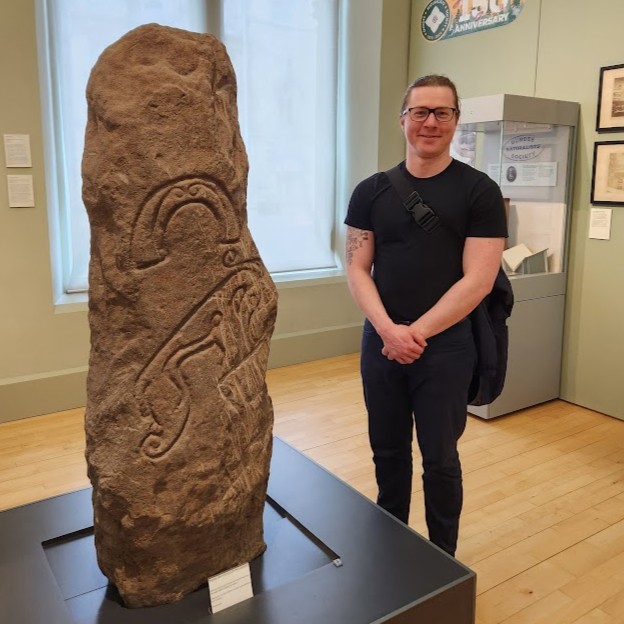David John Osgarby
Room 103
3 University Gardens
Glasgow G12 8QQ
https://orcid.org/0000-0002-5250-2438
Research title: What do the Symbols Say? A Linguistic and Statistical Decipherment of Pictish Symbols
Research Summary
My research aims to compile and compare datasets of Pictish Symbols and Pictish language forms to empirically test the validity of hypotheses about the form and function of Pictish Symbols. This research will build towards a linguistically grounded decipherment of the Pictish Symbol system.
My research questions are:
- How do we determine whether Pictish Symbols represent language, and if so whether they represent words, morphemes, sounds or a combination thereof?
- How do Symbols and Symbol texts vary over time and space?
- What is the purpose of the Symbol Texts, e.g. identifying a person, group or location?
- How do we use historical sources documenting Pictish individuals, groups and locations to decipher Symbol texts?
- What do individual Symbols and Symbol texts encode?
My approach is interdisciplinary. I will apply methods from linguistics, grapholinguistics, and cryptanalysis to provide writing system models that best account for parallel corpora of Pictish Symbols and Pictish language forms. The emerging field of grapholinguistics will provide the formal framework of my research, and the application of digital humanities approaches, such as the creation of interlinked open datasets and the use of standard encoding schemas, will allow me to rapidly and automatedly test complex hypotheses across datasets.
Below are some photos (taken by myself) showing Pictish Symbols carved on objects on permanent public display at the National Museum of Scotland, Edinburgh.
| Woodrae (Reverse) | Hilton of Cadboll | Scoonie |
|---|---|---|
 |
 |
 |
| Brough of Birsay | Ackergill | Fiskavaig |
 |
 |
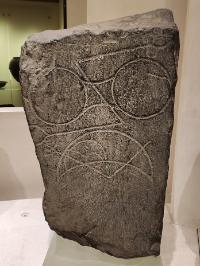 |
| Easterton of Roseisle (Obverse) | Easterton of Roseisle (Reverse) | Monifieth 1 |
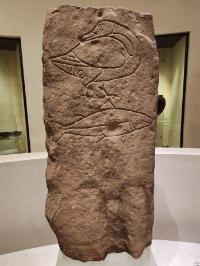 |
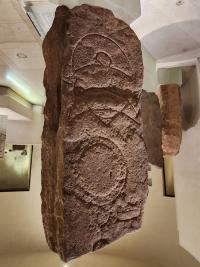 |
 |
| South Ronaldsay (Obverse) | Firth | Kintore 2 (Obverse) |
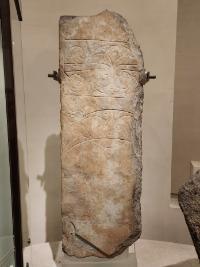 |
 |
 |
| Jarlshof 3 (Stone Disk) & Broch of Burrian (Bone) |
Norrie's Law (Plaques & Pins) & Whitecleuch (Chain Terminus) |
Parkhill |
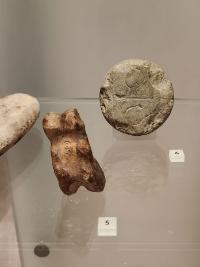 |
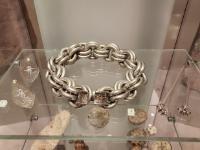 |
 |
Grants
Visiting Doctoral Researcher, Department of Literature, Area Studies and European Languages, University of Oslo (Oslo, 08-11/2026), Funder: Scottish Gradate School for Arts and Humanities
Specialist Training, Dublin Institute for Advanced Studies (DIAS) Celtic Studies Summer School (Dublin, 14-25 July 2025), Funder: Scottish Gradate School for Arts and Humanities
Arts and Humanities Research Council Doctoral Training Program Studentship (AHRC DTP), 10/2024-03/2028, Funder: Scottish Gradate School for Arts and Humanities
Conferences
Recent
Osgarby, David. 2025. ‘Pictish Symbols: Letting Graphetics Inform Graphematics’, 15th AWLL International Workshop on Writing Systems and Literacy, Association for Written Language and Literacy (Pisa, 31 October 2025)
Upcoming
Osgarby, David. 2026. ‘One Script among Many: Carving out the Sociolinguistic Niche of Pictish Symbols’, Writing As Visual Engagement Conference, Visual Interactions in Early Writing Systems, VIEWS (Cambridge, 26-29 March 2026)
Osgarby, David. 2026. ‘What Can a Writing Systems Approach Bring to Understanding Pictish Symbols?’, Pictish Arts Society Lecture Series (Online, 17 April 2026)
Osgarby, David. 2026. ‘Laying the Groundwork for Pictish Symbol Decipherment: Insights from Building and Analysing Comparable Graphematic and Linguistic Corpora’, Philology Meets AI: Understanding Rare Scripts Workshop, Echoes of History: Analysis and Decipherment of Historical Writings, DESCRYPT (Stockholm, 4-5 May 2026)
Osgarby, David. 2026. ‘How to decipher an ancient script carved on Scottish stones’, SGSAH Year 2 Symposium, Scottish Graduate School for Arts and Humanities (Glasgow, 23 June 2026)
Teaching
Guest Lecturer, 2025-6 Semester 2, Literacy In Medieval Celtic Societies (CELTCIV5034), University of Glasgow
Graduate Teaching Assistant, 2025-6 Semester 2, Celtic Civilisation 1B (AD 400-1066) (CELTCIV1002), University of Glasgow
Graduate Teaching Assistant, 2025-6 Semester 1, Celtic Civilisation 1A (1000 BC–AD 400) (CELTCIV1001), University of Glasgow
Additional Information
Publications
Osgarby, D., & Bowern C. (2023) ‘Complex predicates and serialization’. In C. Bowern (Ed.), The Oxford Guide to Australian Languages. pp. 291-308. Oxford: Oxford University Press. https://doi.org/10.1093/oso/9780198824978.003.0026.
Meakins, F., Ennever, T., Osgarby, D., Browne, M., & Hamilton-Hollaway, A. (2023) ‘Ngumpin-Yapa languages’. In C. Bowern (Ed.), The Oxford Guide to Australian Languages. pp. 918-932. Oxford: Oxford University Press. https://doi.org/10.1093/oso/9780198824978.003.0076.
Osgarby, D. (2021) ‘Associated motion in Mudburra and northern central Australian languages’. In A. Guillaume & H. Koch (Eds.), Associated Motion. Empirical Studies in Language Typology. pp. 325-356. Berlin: De Gruyter Mouton. https://doi.org/10.1515/9783110692099-008.
Green, J., Green, R., Hamilton-Hollaway, A., McConvell, P., Meakins, F., Nash, D., Osgarby, D., & Pensalfini, R. (2019) Mudburra to English dictionary. AIATSIS Foundation Series. Canberra: Aboriginal Studies Press. https://shop.aiatsis.gov.au/products/mudburra-to-english-dictionary.
Osgarby, D. (2018). ‘Reconstructing Proto-Mirndi verbal morphology: From particles and clitics to prefixes’. Australian Journal of Linguistics 38(2). https://doi.org/10.1080/07268602.2018.1400504.
Osgarby, D. (2017) ‘Jean-Christophe Verstraete and Diane Hafner (eds), Land and Language in Cape York Peninsula and the Gulf Country, Amsterdam: John Benjamins, 2016, ISBN 9 7890 2726 7603, 492 pp., €110’. Queensland Review 24(2). https://doi.org/10.1017/qre.2017.18.
Áístainskiaakii, Issapóíkoan, Áínnootaa, & Osgarby, D. (2013). ‘Aakíípisskani “the women’s buffalo jump”’. In J. Dunham, P. Littell, & J. Lyon (Eds.), University of British Columbia Working Papers in Linguistics: Papers for ICSNL XLVIII (Vol. 35, pp. 1–21). Vancouver, BC: University of British Columbia. https://lingpapers.sites.olt.ubc.ca/files/2018/01/2013_Aistainskiaakii.pdf.


